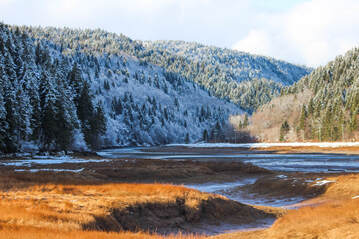 Image by Kat Hallett
Image by Kat Hallett
Gail Chmura, a professor at McGill University, had recently joined the school’s geography department in the late 1990s when some of her colleagues were trying to solve a mystery. They were looking at global carbon budgets, and the numbers weren’t adding up. There was a missing carbon sink, sequestering a whole lot of carbon, and nobody knew what it was. They wondered if Canada’s peatlands were part of the missing sink.
Meanwhile, Chmura was sampling salt marshes in the Bay of Fundy, which spans between New Brunswick and Nova Scotia. Few people had paid salt marshes any attention as carbon sinks because the data showed pretty low levels of carbon at first glance. But Chmura had a lightbulb moment.
She adjusted her measurements to be based on the actual weight of carbon contained in the soil rather than on the percentage of weight and was struck by her findings: salt marshes stored lots of carbon. They could even store more than peatlands.
“I didn’t think anyone was going to believe me,” she said with a laugh.
But she was right. Over her years of researching the Bay of Fundy, she found the bay’s salt marshes contain more than 14.2 million tonnes of organic carbon, which it has been accumulating for 3,000 years. That’s equivalent to emissions from over 106 million barrels of oil being consumed.
The carbon stored in ocean and coastal ecosystems like marshes, seagrasses and mangroves was dubbed “blue carbon” by environmental non-governmental organizations in 2009, and Chmura has gained a reputation as a blue carbon expert.
The ocean’s vegetated habitats (like mangroves and salt marshes) cover less than two per cent of the ocean floor, but they hold over half of the carbon stored in ocean sediments. A 2009 report, Blue Carbon: The Role of Healthy Oceans in Binding Carbon, estimated preserving and recovering these ecosystems could offset three to seven per cent of global fossil fuel emissions over the course of two decades.
Instead, like so many ecosystems The Narwhal has explored in the Carbon Cache series, coastal ecosystems have continued to be desecrated over time. Wetlands are threatened by rising sea levels, warmer oceans, erosion and pollution. The Blue Carbon Initiative estimates 340,000 to 980,000 hectares of blue carbon ecosystems are destroyed each year, releasing their stored carbon into the atmosphere.
 Image by Kevin Snair of www.creativeimagery.ca
Image by Kevin Snair of www.creativeimagery.ca Despite its degradation, Chmura says the Bay of Fundy is exceptionally well-situated to withstand climate change. The bay and the St. Lawrence River, which is also abundant with wetlands, are more resilient to sea level rise since they already experience such high tides.
“These northern marshes may be the future of salt marshes because [marshes] are highly threatened in the United States to the south,” Chmura said. . . .
For example, Chmura co-authored a study that found a salt marsh on the St. Lawrence River continued to store carbon at the same rate when it was grazed by sheep. Not only that, salt marsh lamb — l’agneau de pré-salé — is a highly sought-after meal in Europe.
“It’s supposed to be very tasty,” she said. One day soon, Chmura said, perhaps farmers could raise sheep on salt marshes and earn income from selling meat in addition to carbon credits, once they can prove how much carbon is still being sequestered. Chmura believes there are opportunities for ecotourism, as well.
“You can have your marsh and eat it too,” she said.
On a national scale, the federal government is also in the midst of developing its own carbon offset standard, which will set the parameters for a variety of carbon credits.
In the face of climate change, restoring salt marshes may in fact be one of the best ways to protect agricultural land by creating a buffer zone. Many of the Bay of Fundy’s salt marshes disappeared due to dikes being built so that the nutrient-rich soil could be used for agriculture. But as sea level rises and dikes erode, those lands are now at high risk of flooding.
It’s about building smarter and working with nature and building up natural processes.
With funding from Fisheries and Oceans Canada’s coastal restoration fund, van Proosdij has been leading efforts to strategically reflood areas the Nova Scotia Department of Agriculture has identified as being cut off from tidal flows due to dikes and at risk of being flooded anyway. Instead of building the dikes up higher, reflooding restores salt marsh habitat.
The change can be quick. Her team reintroduced tidal flow at one site in the Bay of Fundy in 2018, and salt marsh plants and shore birds have already returned to the area.
Re-introducing these marshes creates a buffer that can absorb water, decrease wave intensity and provide more space between the dike and land that’s being used for other purposes like agriculture. It also gives people like van Proosdij the opportunity to measure how much carbon is stored in the marshes and how that changes as they evolve and grow.
“We’re definitely not taking down all dikes in the Bay of Fundy to reflood the land,” she said. “We’re strategically realigning in certain areas to make the land more resilient to withstand climate change impacts by creating a buffer in front of the dike.”
Read the whole article at thenarwhal.ca/blue-carbon-climate-change-canada
This is the eighth part of an ongoing series about nature-based climate solutions in The Narwhal.
 RSS Feed
RSS Feed